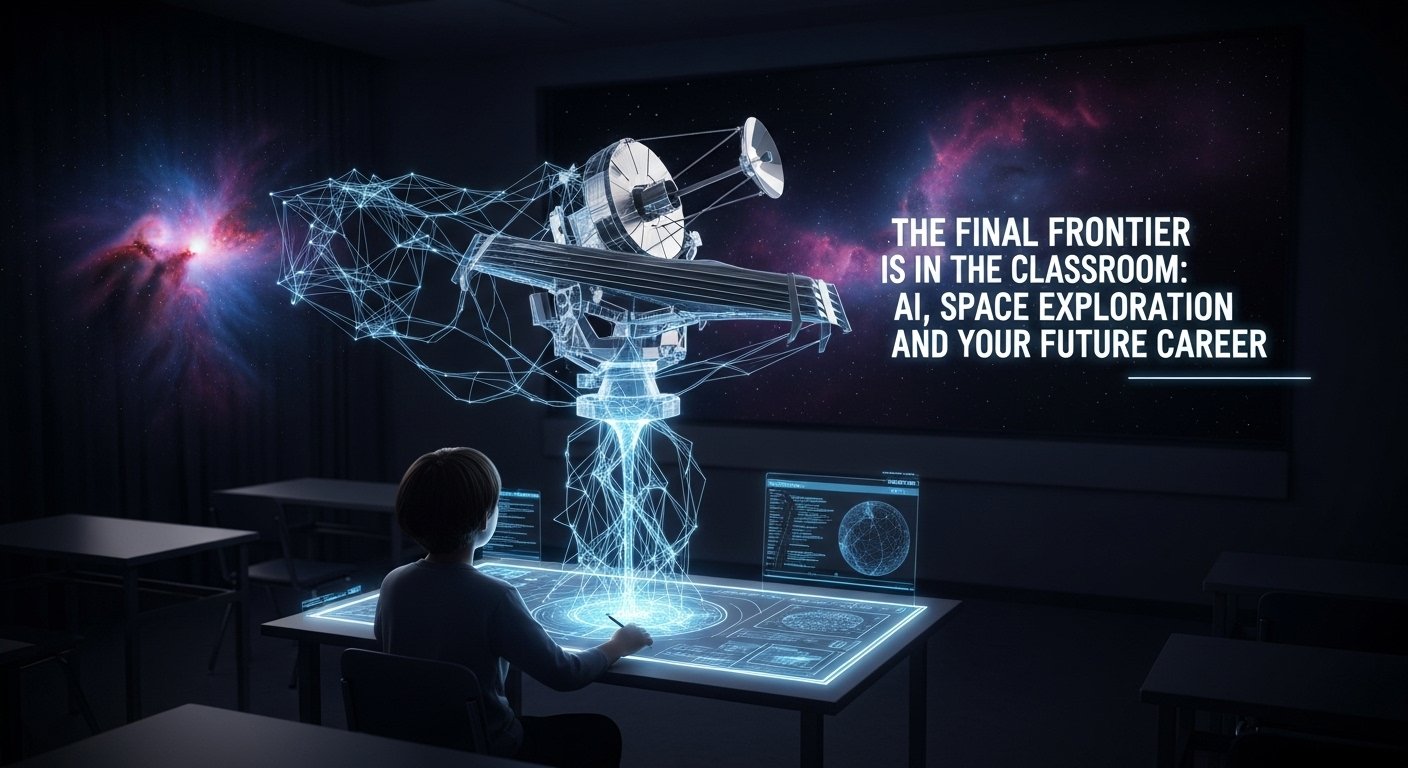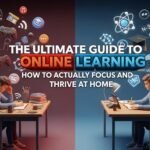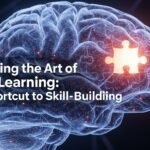The Final Frontier is in the Classroom: AI, Space Exploration, and Your Future Career
Picture this: a colossal digital eye, a million miles from Earth, captures a snapshot of the universe so vast it contains over 250,000 galaxies. This isn’t science fiction; it’s a single deep field image from the James Webb Space Telescope (JWST). Now, imagine the sheer volume of data in that one picture. How could any team of human scientists possibly analyze it all in a lifetime? The answer is they can’t—not alone, anyway. The silent, indispensable partner in this grand cosmic quest is Artificial Intelligence. But this raises a more profound question: if AI is essential for exploring the stars, how do we prepare the next generation of explorers to use it? The answer begins long before they ever get to NASA. It begins with AI in education.
For today’s students in the US and around the world, the dream of space is no longer just about becoming an astronaut. It’s about becoming a data scientist who discovers new exoplanets from their laptop, an engineer who designs self-learning rovers, or an ethicist who programs the moral compass for autonomous spacecraft. The launchpad for these incredible careers is a classroom supercharged by AI in education. This isn’t just about adding fancy tech to lesson plans; it’s a fundamental reimagining of how we teach and learn about the universe, transforming abstract concepts into interactive, data-driven discoveries.
Meta Description: Explore AI in education applications for space discoveries, career paths, and STEM opportunities for aspiring US astronauts.
The New Cosmic Challenge: A Tsunami of Data
For centuries, astronomy was a field defined by scarcity. Limited telescope time and painstaking manual observations meant data was a precious commodity. Today, the challenge has flipped entirely. We are drowning in data, and it’s a fantastic problem to have.
Missions like NASA’s Transiting Exoplanet Survey Satellite (TESS) and the upcoming Vera C. Rubin Observatory are set to generate petabytes of data—that’s millions of gigabytes. Sifting through this digital haystack for the “needle” of a habitable planet or a strange new supernova is a task beyond human capability. This is where AI makes the leap from a helpful tool to an essential partner.
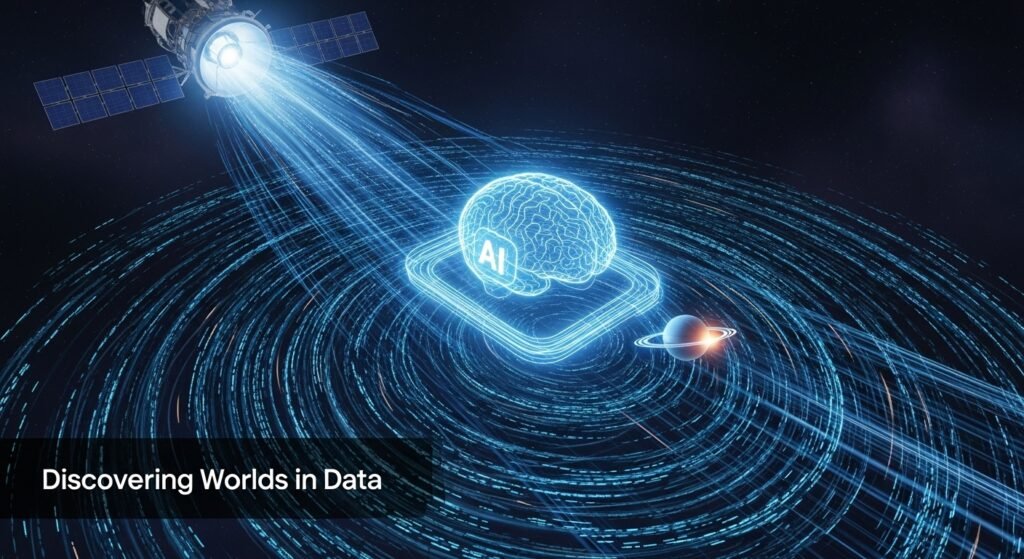
How AI is Already the Co-Pilot in Space Discovery
Before we look at the classroom, let’s appreciate how AI is already a seasoned veteran in space exploration:
- Discovering New Worlds: AI algorithms are the galaxy’s best detectives. They scan thousands of stars at once, looking for the tell-tale dip in light that indicates a planet is passing in front of its star. In 2017, Google’s AI helped NASA astronomers discover two new exoplanets, including Kepler-90i, by analyzing old data from the Kepler space telescope that human eyes had missed. This demonstrates AI’s power to see patterns we can’t.
- Driving on Mars: NASA’s Perseverance rover is a marvel of autonomous exploration. Its advanced AutoNav system uses AI to analyze 3D maps of the Martian terrain, identify hazards, and plot the safest and most efficient route—all without real-time commands from Earth. This AI-driven independence allows it to cover more ground and make more discoveries than any previous rover.
- Decoding the Universe’s Baby Pictures: The stunning images from the JWST are not just pretty pictures; they are complex datasets. AI helps scientists classify galaxies, identify gravitational lensing (where gravity from a massive object bends light), and find anomalies that could point to new cosmic phenomena. It accelerates the pace of discovery from years to weeks.
The takeaway is clear: the future of space exploration is inextricably linked with AI. Therefore, the future of space exploration education must be as well. This is the urgent and exciting mission for AI in education.
Top Mental Health Resources for College Students
From Textbooks to Star Treks: The Role of AI in Education
If the tools of professional astronomers are AI-powered, then the learning tools for aspiring astronomers must be, too. The traditional model of memorizing planets and looking at static pictures in a textbook is no longer sufficient. AI in education is bridging the gap between the classroom and the cosmos, creating dynamic, personalized, and deeply engaging learning experiences.
Personalized Learning Paths to the Planets
Not every student learns physics at the same pace. One might grasp orbital mechanics instantly, while another struggles with the concept of gravity. AI-powered adaptive learning platforms can create a unique educational journey for each student.
Imagine an AI tutor that presents a student with a challenge: “Plan a trajectory from Earth to Mars.” Based on the student’s answers, the AI can:
- Instantly identify knowledge gaps (e.g., misunderstanding Hohmann transfers).
- Provide targeted resources, like a short video explaining the concept or an interactive simulation.
- Adjust the difficulty of the next challenge, ensuring the student is always learning at the edge of their ability.
This isn’t about replacing teachers. It’s about giving teachers a powerful assistant that can provide individualized support to every student, freeing up the teacher to focus on fostering curiosity and critical thinking. This is AI in education at its best.
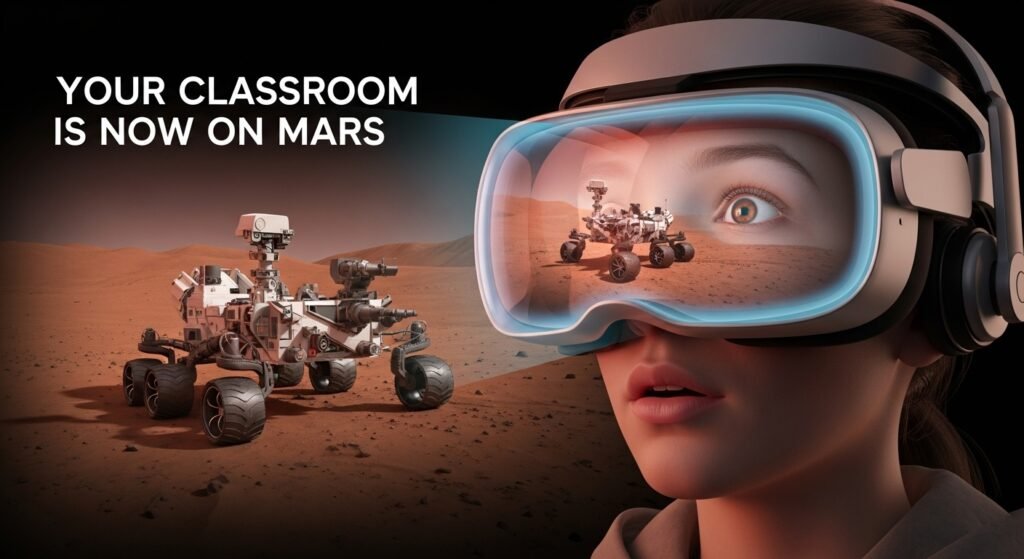
Hyper-Realistic Simulations: VR Spacewalks and Mars Landings
Reading about the vacuum of space is one thing. Experiencing a simulated spacewalk outside the International Space Station (ISS) in a VR headset is another. AI is making these simulations more realistic and responsive than ever.
AI algorithms can generate dynamic scenarios based on real-world physics. A student practicing a virtual Mars landing won’t face the same pre-programmed challenges every time. The AI can introduce unexpected events—a sudden dust storm, a sensor malfunction—forcing the student to problem-solve in real-time. This kind of experiential learning builds not just knowledge, but also the critical skills of adaptability and resilience required for real space missions.
Making Big Data Bite-Sized for Student Researchers
One of the most exciting frontiers for AI in education is making authentic scientific research accessible to students. Instead of just reading about exoplanet discoveries, students can now participate in them.
Platforms are emerging that use AI to curate and simplify massive datasets from NASA. A student can log in, choose a star system, and with the help of an AI guide, analyze real light-curve data from TESS. The AI can help them:
- Clean up “noise” in the data.
- Identify potential transit signals.
- Compare their findings with known planetary systems.
This transforms students from passive learners into active participants in the scientific process. It’s a profound shift that fosters a deep, lasting passion for STEM.
Top Mental Health Resources for College Students
The Evolution of the Space Explorer: Old School vs. AI-Powered
The skillset required to contribute to space exploration has undergone a dramatic evolution. The romantic image of the lone astronomer at a telescope has been replaced by collaborative teams of data scientists, programmers, and engineers.
| The “Old School” Space Cadet | The “AI-Powered” Space Cadet |
| Primary Skill: Memorization (planets, constellations, formulas). | Primary Skill: Critical Thinking & Data Analysis. |
| Key Tool: Physical telescope, star charts, textbooks. | Key Tool: AI-powered analysis software, coding languages (Python), VR/AR simulations. |
| Learning Process: Passive (reading, listening to lectures). | Learning Process: Active & Interactive (analyzing real data, problem-solving in sims). |
| Relationship with Data: Consumes conclusions from data. | Relationship with Data: Generates new conclusions from raw data. |
| Dream Job: Astronaut, Astronomer. | Dream Job: AI Data Scientist, Robotics Ethicist, Autonomous Systems Engineer, Astronaut. |
Export to Sheets
This table clearly shows that while the passion for the stars remains the same, the path to engaging with them has been revolutionized. AI in education is the engine of this revolution.
Best Remote Internship Programs in 2025
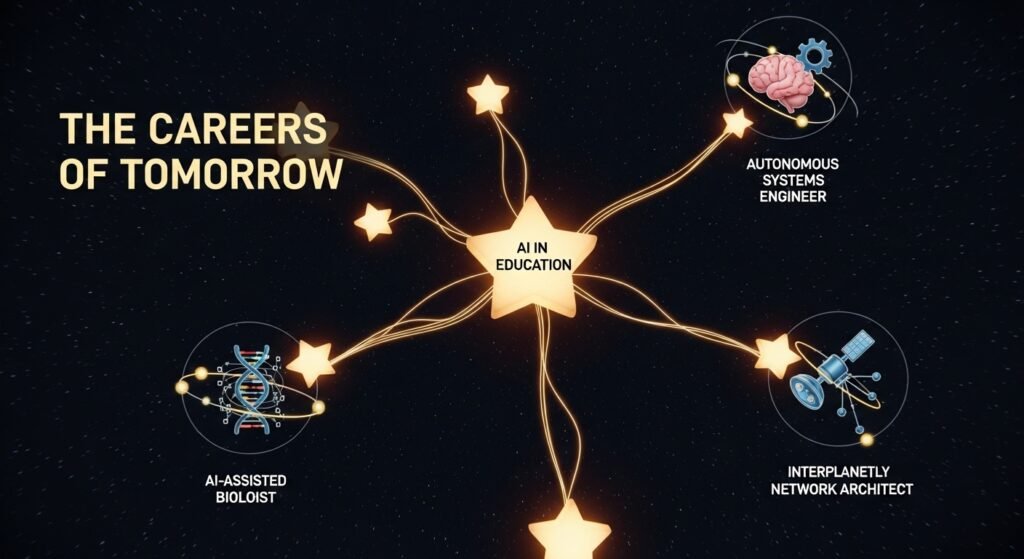
Launching Your Career: The New Jobs at the Intersection of AI and Space
When I was a kid, if you loved space, you had a handful of career paths you could name. Today, the landscape is exploding with new roles that didn’t exist a decade ago, many of them requiring a blend of AI and space science expertise. For any US student dreaming of the stars, these are the careers to watch.
1. Astroinformatics Specialist / AI Data Analyst
This is the modern-day astronomer. You won’t be looking through an eyepiece; you’ll be designing the neural networks that sift through petabytes of cosmic data. You’ll be the one to spot the anomaly that leads to the discovery of a new type of star or a planet with a strange atmosphere.
- Skills Needed: Strong background in computer science, machine learning, data analysis, and astrophysics.
2. Autonomous Systems Engineer
These are the architects of the “brains” behind missions like the Perseverance rover or future self-directing deep space probes. You’ll design, build, and test the AI that allows spacecraft to make critical decisions light-years from home.
- Skills Needed: Robotics, AI programming, systems engineering, control theory.
3. Space Robotics Ethicist
As AI becomes more autonomous, profound ethical questions arise. If a rover on Mars faces a choice between completing its primary science mission or saving itself from a potential hazard, how should it decide? A robotics ethicist works with engineers and scientists to program a moral and ethical framework into these autonomous systems.
- Skills Needed: Philosophy, ethics, law, computer science, public policy.
4. Interplanetary Network Architect
Future colonies on the Moon and Mars will require a complex web of communication satellites, all managed and optimized by AI to handle signal delays and disruptions. These architects will design the “internet” of the solar system.
- Skills Needed: Network engineering, AI, cybersecurity, astrophysics.
5. AI-Assisted Space Biologist
How does life adapt to the harsh environment of space? How can we terraform Mars? These biologists will use AI to analyze vast amounts of genomic data from extremophiles on Earth and experiments on the ISS to model how life could survive—and thrive—on other worlds.
- Skills Needed: Biology, genetics, data science, machine learning, environmental science.
These roles illustrate that the future of space exploration is as much about data and code as it is about rockets and fuel. Preparing for these careers starts now, with a strong foundation in AI in education.
Best Remote Internship Programs in 2025
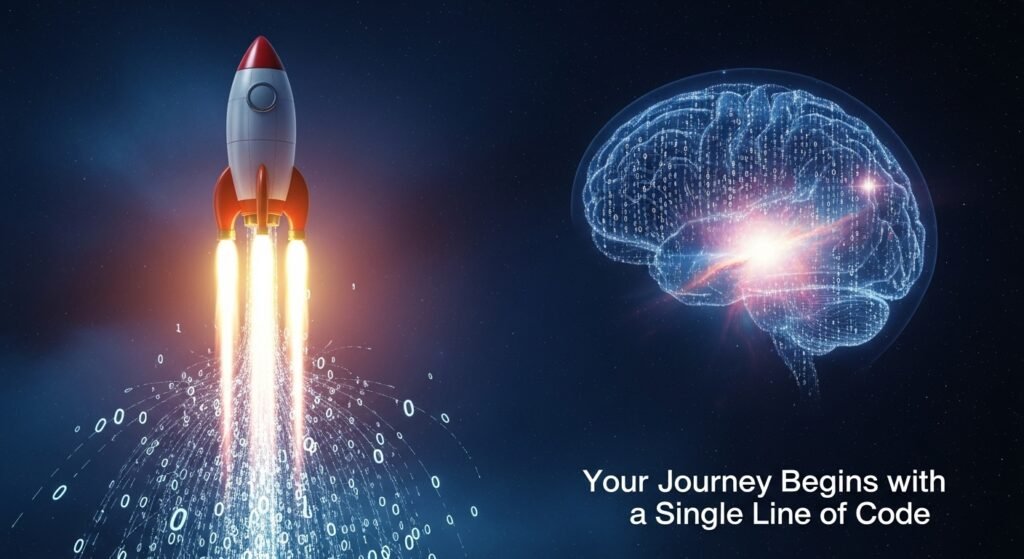
Conclusion: The Universe is Calling, and It Speaks in Data
The journey to the stars no longer begins at the launchpad; it begins in the classroom with a laptop. The awe and wonder that space inspires remain the same, but the tools we use to explore it have been fundamentally transformed. AI is not just another subject to be taught; it is the lens through which we will make the next generation of cosmic discoveries.
For students, this is an incredible time to be alive. You have the opportunity to engage with the universe in ways previous generations could only dream of. By embracing the tools of AI in education, you are not just preparing for a final exam; you are preparing for a future among the stars. You are learning the language of the modern universe: data. So, dive in, get your hands on the data, play with the simulations, and start building the future. The cosmos is waiting.
What future space mission powered by AI would you love to be a part of? Share your dream project in the comments below!
AI is crucial because missions like the James Webb Space Telescope produce a massive amount of data (petabytes) that is impossible for humans to analyze alone. AI algorithms can sift through this data much faster to find new exoplanets, classify galaxies, and identify unique cosmic phenomena.
AI is already being used in several key ways:
Discovering New Planets: AI has helped NASA find new planets by analyzing old data from telescopes like Kepler.
Autonomous Rovers: NASA’s Perseverance rover on Mars uses an AI system (AutoNav) to understand the terrain and navigate its path safely on its own.
Image Analysis: AI assists scientists in analyzing the complex images captured by the James Webb Telescope to speed up discoveries.
Beyond traditional roles like being an astronaut, many new career paths are emerging, such as:
Astroinformatics Specialist (An AI expert for space data)
Autonomous Systems Engineer (Designs the AI brains for rovers and probes)
Space Robotics Ethicist (Creates the moral and ethical frameworks for AI)
AI-Assisted Space Biologist
AI can prepare students by transforming the learning process in several ways:
Providing personalized learning paths tailored to each student’s needs and pace.
Creating realistic simulations of space missions using Virtual Reality (VR).
Giving students the opportunity to work with real scientific data from NASA for research projects.

